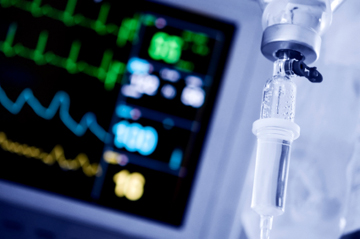
Putting patients with severe head injuries or persistent seizures into a medically induced coma currently requires constant monitoring. A nurse or other health professional must watch over the patient’s brain activity, manually adjusting drug infusion to maintain a deep state of anesthesia.
Now a computer-controlled system developed by Massachusetts General Hospital investigators promises to automate the process, making it more precise and efficient while also opening the door to more advanced control of anesthesia. The team, including colleagues from MIT, recently reported their success in animals in the journal PLOS Computational Biology.
“People have been interested for years in finding a way to control anesthesia automatically,” said Emery Brown, the HMS Warren M. Zapol Professor of Anaesthesia at Mass General and the Edward Hood Taplin Professor of Medical Engineering and Computational Neuroscience at MIT. He is the senior author of the paper. “To use an analogy that compares giving anesthesia to flying a plane, the way it’s been done is like flying a direct course for hours or even days without using an autopilot. This is really something that we should have a computer doing.”
As part of a long-term project investigating the physiological basis of general anesthesia, Brown’s team at Mass General and MIT has identified and studied patterns of brain activity reflecting various states of anesthesia. One of the deepest states, called burst suppression, is characterized by an EEG pattern in which brief periods of brain activity—the bursts—are interrupted by stretches of greatly reduced activity that can last for seconds or longer.
Patients with serious head injuries that cause a buildup of pressure within the skull or those with persistent seizures are put into a medically induced coma to protect against additional damage. During this period, the goal is to maintain brain activity in a state of burst suppression.
Although anesthesiologists have had computer-assisted technologies for many years, no FDA-approved system exists that completely controls anesthesia administration based on continuous monitoring of a patient’s brain activity. Until the current study, Brown said, no one had demonstrated the level of control required for a completely automated system.
Keeping patients at a precise level of brain activity for several days, as required for medically induced coma, appeared to be both a feasible goal and one that cried out for the sort of computer-controlled system called a brain-machine interface.
Adapting programs they had previously developed to analyze the activity of neurons, Brown’s team developed algorithms to read and analyze an EEG pattern in real time and determine a target level of brain activity—in this case, burst suppression. Based on that target, an automated control device adjusts the flow of an anesthetic drug to achieve the desired brain state. Real-time analysis of the continuous EEG readings is fed back to the system to ensure the target level is maintained.
When the researchers tested their system in a rodent model, the actual EEG-based measure of burst suppression tracked the target trajectory almost exactly.
“As far as we know, these are the best results for automated control of anesthesia that have ever been published,” said Brown. “We’re now in discussions with the FDA for approval to start testing this in patients.”
Among the benefits of such a system would be the ability to maintain medical coma at a more precise, consistent level than can be done manually, Brown explained. Lower doses of anesthetic drugs could be used, based on reductions possible with computer-assisted technology. Mass General has applied for a patent for the technology.
Eliminating the need to devote one intensive-care nurse on each shift to continuous monitoring of one patient would significantly change ICU staffing needs. Further development of the system to control and maintain the full range of anesthesia states could introduce a new tool for other needs.
Primary support for this work came from a National Institutes of Health Director’s Pioneer Award to Brown.
Adapted from a Mass General news release.


